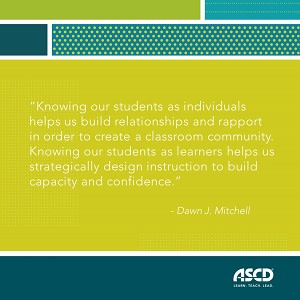When was the last time you taught strictly according to your lesson plan? Can’t remember?
That’s what I thought.
We anticipate how lessons will progress as we plan, and as they play out, but we also need to remember that every lesson is a continuous feedback loop. We reflect and ask ourselves so many questions as we are teaching and as we observe students in action. “How are the students responding? Are they listening? What are they thinking? Are they engaged? What questions do they have? Are they meeting the objective and expectation?”
So you set up the lesson for your students, whatever that may look like, then you observe and gather your formative data. As you observe, what do you do with that continuous feedback? What if “the plan” isn’t working? What do you do?
Follow Dory’s advice: just keep swimming! You have to think fast and make a quick decision. You determine whether or not students are getting it as you observe: listening into conversations, watching interactions, asking questions about their thinking. If you observe success, what kind of feedback or guidance do you provide in that moment to extend their learning? If not, how long do you wait before you clarify misconceptions at that time? How do you decide to respond to their feedback?
Here are three things to go with the flow and get the most out of those teachable moments:
- Determine who needs what – and quick: Your lesson can derail faster than you expect if you don’t anticipate it. Take a quick scan of your classroom to determine who’s on track and who’s not. Notice the level of engagement in an activity, student conversations, and the number and types of questions being asked. If students have many questions, meet the needs of the entire group. Take that moment to clarify any miscommunication of the objective or expectation. Is there something posted for their reference? Do they have what they need to do what you expect? Ask them what they need in that moment. There is power and ownership when your students can voice what they need to be successful as a learning community. If only a small number that are off track, gather the small group and allow the others to continue. First, determine the level of intervention needed by listening to students, then make the decision on how to proceed. You may just have students walk around and observe their peers to get an idea about what to do, or you may need to provide explicit direction.
- Teach through misconception: Students have many misconceptions about so many ideas. Providing students a chance to voice their ideas, or even presenting students with a set of misconceptions that you know ring true within your student’s set of ideas, is a very powerful way to teach in the moment. One of the greatest set of lessons I’ve experienced was teaching through misconceptions about space. Listening to student ideas about whether the sun actually sets or whether the moon comes out at night provided opportunities for students to dig into multiple resources and have deep conversations. These lessons were chalk-full of teachable moments within small group research. As they found out information, they started asking more questions. That discovery of learning of what you thought was the truth when it was actually a myth, is a powerful way to ensure students are really searching and comprehending what they are inquiring into. Those formative anecdotes are essential to really teaching in the moment to push a student’s thinking into a new mental framework. These are powerful moments to guide students through further inquiry of their thoughts at that time. At any level and learning ability, we can provide students with statements and questions that will guide their thinking in the direction it should go. Having the confidence and know-how to bring students back to the benchmark or objective takes skill and bravery on your part. It is not easy to teach this way. There is much to anticipate with student response.
- Extend thinking: Do not miss those moments to extend learning opportunities for students who are easily meeting the objective. Your lesson can flop even when students find the activity too easy as well. Take that opportunity to ask students the process and purpose for what they are engaging in. How can you extend their thinking and learning experience? Can you provide them with open-ended questions that they can have a discussion or debate about or can you provide them with some time to inquire into an idea through researching? Can you have them work with peers to provide each other with feedback? Teaching in the moment means thinking beyond the expectation as well.
Using unexpected moments to teach and guide student thinking is one of the most exciting parts of teaching. Opportunities arise for great teaching when lessons fail miserably or when students share ideas you weren’t expecting, These are what make teachers creative, flexible and good at what they do.








